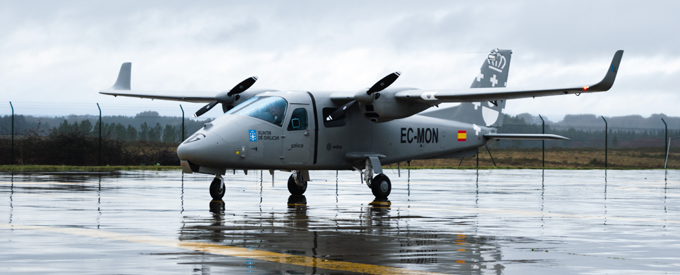2020-09-01
Indra Successfully Tests Targus OPV
Indra recently successfully completed the first test flights with its Optionally Piloted Vehicle (OPV) Targus. This led to achieving one of the decisive milestones of the Civil UAVs Initiative, promoted by the Government of Galicia, Spain, to make the region a leader in this industry.
Indra has carried out these experimental flights in non-segregated airspace with a drone that weighs 1.25 tonnes and has an 11-metre wingspan.
No other newly developed UAV had been granted permission to carry out such flights before. This a landmark for Spanish aviation and a step forward for development in this sector.
The first flight took place on June 24 and was the start of a series of tests that were conducted over two weeks. All those flights comply with the Approval of Flight Conditions issued by the European Union Aviation Safety Agency (EASA) and with the Flight Approval by the Aviation Safety and Security Agency (AESA) of Spain, which authorises their testing.
A special communication protocol was also established with the air traffic control of Santiago de Compostela Airport.
Aboard the Targus, the test pilot carried out the take-off manoeuvre and, once the aircraft was airborne, handed over control to the ground control centre.
From that moment on, the work of Indra and Gaerum’s engineers began: their job was to verify that all sensors and flight control systems worked properly.
Fast Paced Progress
To have obtained the approval of Flight Conditions for an OPV from the EASA to fly it is a success of great importance in itself since it is a process that had not been carried out before and it provides a competitive advantage for the future.
Indra’s strategy to develop a drone that can carry a pilot in the cockpit to take control if necessary or hand it over to the ground station, as appropriate, has allowed this project to progress at a very fast pace.
It also offers a great operational advantage for future users, who will be able to fly over urban areas or land at airports without restrictions when manned and fly without a pilot when it arrives at the operation area. This dual use significantly enhances the commercial appeal and capabilities of Targus.
The project now enters its final stage to finish the development of the OPV this year. The Targus will then become one of the most advanced and efficient aircraft for conducting missions such as air-sea rescue, fishery zone surveillance, environmental protection, detection of discharges in the sea, monitoring land use and historical heritage sites and providing support to firefighting.


No Comments